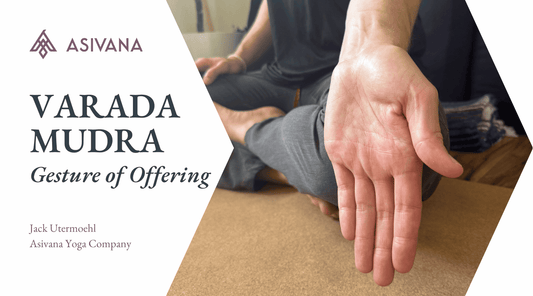
Dhyana Mudra - Gesture of Meditation
Jack UtermoehlShare
Dhyana Mudra - Gesture of Meditation
Sanskrit Name: Dhyāna Mudrā
English Translation: Gesture of Meditation
Phonetic Spelling: dhyä-nuh moo-drah
Dhyana mudra, the "gesture of meditation," serves as a powerful tool for cultivating inner stillness, focus, and spiritual alignment. This mudra symbolizes the balance between the active and receptive energies within, embodying the harmony of opposites—an essential aspect of meditation.
Energetically, dhyana mudra directs the practitioner’s awareness inward, aligning the mind, body, and spirit.
It is closely associated with Ajna (third eye) chakra and Sahasrara (crown) chakra, facilitating heightened intuition and a sense of unity with the universe. The downward orientation of the hands in this mudra represents grounding, while the circular placement of the fingers symbolizes completeness and continuity.
Practicing this mudra can bring mental clarity, emotional tranquility, and spiritual expansion, offering a pathway to experience the deeper essence of one’s being.

Instructions to Perform Dhyana Mudra
Choose a grounded meditative posture, such as sukhasana (easy pose). Ensure your spine is upright, shoulders relaxed, and body at ease.
Hand Position: Place your left hand palm-up in your lap. Rest your right hand on top of the left, also palm-up. Touch the tips of your thumbs and index fingers lightly together, forming a circular shape on each hand while pressing index fingers together.
Posture: Ensure that your mudra is comfortably balanced in your lap, close to your lower abdomen. Your elbows should be relaxed, and your hands steady.
Breathing Technique: Practice slow, deep belly breathing. Focus on each inhale filling your body with calm energy and each exhale releasing tension.
Duration: Hold the mudra for 5-15 minutes during meditation, gradually increasing the duration as your practice deepens.
Benefits of Dhyana Mudra
Dhyana mudra enhances the state of meditation by clearing the mind of external distractions.
Physical Benefits: Enhances deep breathing and oxygenation, calms the nervous system, and supports better posture and alignment during meditation.
Mental Benefits: Encourages clarity of thought and focus, reduces mental chatter, and strengthens the practitioner’s ability to concentrate.
Emotional Benefits: Alleviates stress and anxiety, balances emotional fluctuations, and fosters a sense of contentment and serenity.
Spiritual Benefits: Awakens higher states of consciousness, facilitates a connection to divine energy and universal truth, and encourages the integration of meditation into daily life.
Elevate Your Mudra Practice
Capture your insights and deepen your connection with our Yoga Journal.
Symbolism and Meaning of Dhyana Mudra
Dhyana Mudra embodies the essence of meditation—stilling the mind and harmonizing inner energies to connect with higher realms of awareness. The hands’ placement signifies balance, receptivity, and the transformative journey inward. The circle formed by the thumbs represents unity and the infinite nature of existence.
In Buddhist art, this mudra’s depiction often relates to stories of enlightenment and spiritual liberation. Its connection to yogic concepts like prana (life force) and dhyana (contemplation) emphasizes its role in advancing self-realization and spiritual growth.
When to Practice Dhyana Mudra
- During seated meditation or pranayama.
- At the start or end of a yoga practice to center your energy.
- In moments of stress or overwhelm to regain equilibrium.
- In daily meditation sessions to deepen focus and stillness.
A duration of 5-15 minutes daily, or longer as part of an extended meditation routine.
Contraindications for Dhyana Mudra
- Avoid if experiencing severe physical discomfort while sitting; modify posture as needed.
- Ensure hands and arms are supported if fatigue arises.
- If mental agitation persists, pair the mudra with calming pranayama or grounding techniques.
Additional Insights on Dhyana Mudra
Affirmations: “I am calm, centered, and in harmony with the universe.” / “I open myself to the infinite wisdom within.”
Visualization: As you hold Dhyana Mudra, visualize a serene lotus flower blooming at your crown chakra, radiating light and calmness through your being. Imagine this light expanding outward, connecting you with universal energy.
Associated Chakras: Ajna (third eye chakra) which enhances intuition and inner vision and sahasrara (crown chakra) which connects to divine consciousness and spiritual awakening.
Paired Asanas: Paired well with any form of seated posture for meditation such as padmasana (lotus pose) and sukhasana (easy pose).
Related Pranayama: Sama Vritti (Equal Breathing)
Meditation Techniques: Mindfulness of breath and mantra chanting, such as “Om.”
Variations and Modifications
Alternative Hand Positions: Bhairava Mudra, Jnana Mudra, Dharmadhatu Mudra
Adaptations for Beginners: Shorten practice time to 2-5 minutes. Sit in a chair with feet flat on the ground for added support.
—— 🕉 ——

Personal Insights
In my personal practice, Dhyana mudra felt a little weird to use in meditation but that weirdness quickly grew into a focal point. I noticed that as my knuckles pressed inward my mind opened to more space between thoughts.
As the gap widened, I became more peaceful, time elongated, and my meditation reached new heights.
If your hands and wrists feel ok, I would encourage you to sit with Dhyana mudra for 10 or 15 minutes and have your own experience. Let me know in the comments how it goes!











